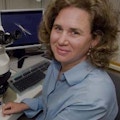Sonya Dyhrman, Ph.D.
Professor, Department of Earth and Environmental Sciences, Columbia UniversitySonya Dyhrman’s website
SCOPE-ALOHA Project: The ‘Keystone’ Microbiome of the North Pacific Subtropical Gyre (NPSG)
Photoautotrophs, like cyanobacteria and the eukaryotic algae (phytoplankton), play a critical role in the fixation of carbon, driving the biological pump in the global ocean. In oligotrophic gyres such as the North Pacific Subtropical Gyre (NPSG), cyanobacteria and phytoplankton are typically small (less than 2 micrometers) and at much higher abundance than larger microbes. However, these large, rare microbes, including the diazotroph Trichodesmium and phytoplankton from the dinoflagellate, haptophyte and diatom functional groups, may serve a ‘keystone’ role in shaping ecosystem dynamics and biogeochemical consequences. For example, these groups are known to mediate critical activities related to ecosystem function, such as fixing nitrogen and carbon, calcifying, forming symbiotic or parasitic associations, ballasting carbon export, and shaping organic matter composition. Modulations in the physiological ecology of these populations could play a disproportionate or ‘keystone’ role in shaping marine microbial community structure, function and biogeochemistry.
To further the SCOPE mission, we will work to characterize the mechanistic underpinnings of resource metabolism pathways in these functional groups. This mechanistic understanding will then be used to examine how metabolic pathways are influenced by taxonomic composition, modulated over time, with depth and in response to changes in the environment. Tracking metabolism in this way is newly feasible, particularly for the eukaryotic groups, and will allow the linkages between physiological ecology, activities and stoichiometric composition to be defined for refining predictive understanding of these functional groups and the role they play in oligotrophic regions like the NSPG.
Bio:
Sonya Dyhrman is a professor of earth and environmental sciences at Columbia University and the Lamont-Doherty Earth Observatory. Dyhrman graduated with high honors in biology from Dartmouth College and received her Ph.D. in marine biology from the Scripps Institution of Oceanography. She did her postdoctoral training at the Woods Hole Oceanographic Institution (WHOI), where she was a tenured member of the scientific staff until 2014. She was previously awarded an Ocean Life Institute Fellowship to support the development of new molecular tools to track the physiology of ocean microbes. In 2007, she was a Marie Tharp Fellow of the Columbia University Earth Institute, working on ocean acidification. More recently, she was a Sir Allan Sewell Fellow of Australia’s Griffith University, working on toxin-producing cyanobacteria. Dyhrman also served on the scientific steering committee for the U.S. Ocean Carbon and Biogeochemistry Program.
Her research leverages molecular tools to study the physiological ecology of cyanobacteria and eukaryotic microalgae and their role in shaping marine ecosystem structure, function and biogeochemistry. In addition to her research efforts, Dyhrman developed ocean science literacy activities for classrooms and the virtual world Whyville, giving more than one million children exposure to ocean literacy standards and the process of scientific discovery.